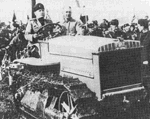The Economy in Fascist Italy
The economy of Fascist Italy was weak. The economy of Italy had made little recovery after World War One and Mussolini knew that this was a major area to address if Italy was to become a major European power.
Mussolini knew that Italy after 1918 was a poor nation compared to France and Britain. Mussolini wanted to advance the economic state of Italy and his plan was based on a two-fold approach: attacking the power of the trade unions and therefore controlling the workers, and setting Italy targets as he had with his Battle for Births. For the attempt to get Italy on the road to economic prosperity, Mussolini introduced three ‘battles’ – the Battle for Land, the Battle of the Lira and the Battle for Grain.
Mussolini and the workers:
The Battle for Land: this ‘battle’ was to clear marshland and make it useable for farming and other purposes. One area that was cleared was the Pontine Marshes – an area of mosquito-infested bog land that was to have housing built on it. Cleared land also had roads built on them to improve Italy’s infrastructure. These schemes were labour intensive and employed a lot of people so they served a purpose in this area. Many saw the Battle of Land as a success.

Mussolini helping to drain the Pontine Marshes
The Battle of the Lira: This ‘battle’ was to restore some of the purchasing power the lira had in bygone days. Mussolini believed that a weak lira looked bad for Italy when he was trying to create the image of a super-power in Europe. A powerful nation could not have a weak national currency. Mussolini inflated the value of the lira making exports more expensive. This created unemployment at home as many industries and firms could not sell their goods. This particular battle proved a failure primarily as the economic base of Italy was too small. She was not an industrial nation but in essence an agricultural one. Basing the strength of your economy on agriculture rarely works and this was the case in Italy. However, Italy got through the Depression in the 1930’a better than Europe’s industrial power houses simply because she was an agricultural nation. The Depression hit the industrial nations of Europe very hard.
The Battle for Grain: Mussolini wanted to make Italy economically stronger and near enough self-sufficient. Hence his desire to grow grain. However, the plan was to grow grain at the expense of fruit and vegetables which were cheaper to produce. Italian grain became expensive at home and the price of bread rose. This hit the poor the worst as bread was a major part of their diet. Rich farmers did well out of this as they were guaranteed a good price for what they produced.
In terms of economic growth, Italy did not have the expanse of industry to bolster her farming based economy. Whereas Germany had its industrial power house in the Ruhr and Britain had South Wales, the North-East, Midlands and North-West, Italy had relatively few of these industrial zones. Though laudable in theory, Mussolini’s plans for Italy’s economic growth were based on weaknesses he could not overcome.